MGT 3201 - Global Business Strategy: Amazon India Case Study
VerifiedAdded on 2023/06/11
|11
|2696
|296
Report
AI Summary
This report provides a detailed analysis of Amazon's global business strategy, with a specific focus on its operations in India. It begins by evaluating various internal and external strategic environment analytical tools, including SWOT analysis, PESTLE analysis, and Porter's Five Forces Framework. The report then delves into an analysis of Amazon's internal environment using SWOT, highlighting the company's strengths, weaknesses, opportunities, and threats. Furthermore, it examines the external environment of Amazon India through a PESTLE analysis, considering political, economic, social, technological, legal, and environmental factors. The analysis concludes that while economic and technological factors support Amazon's functions in India, social and environmental factors require careful consideration. The report suggests that Amazon's success indicates an effective alignment of its global business strategy with the external environment in India. Desklib offers a variety of similar reports and solved assignments for students.
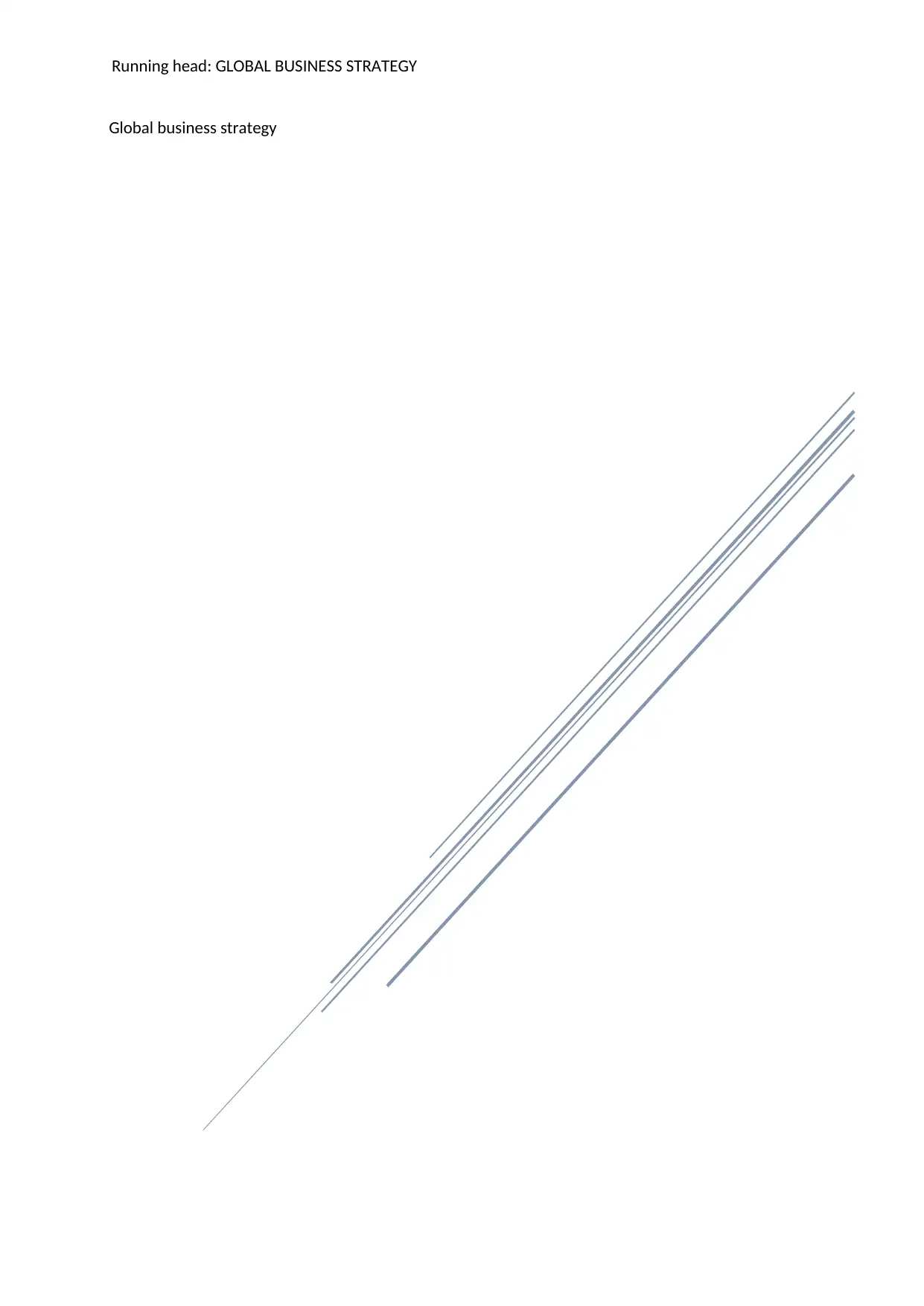
Running head: GLOBAL BUSINESS STRATEGY
Global business strategy
Global business strategy
Paraphrase This Document
Need a fresh take? Get an instant paraphrase of this document with our AI Paraphraser
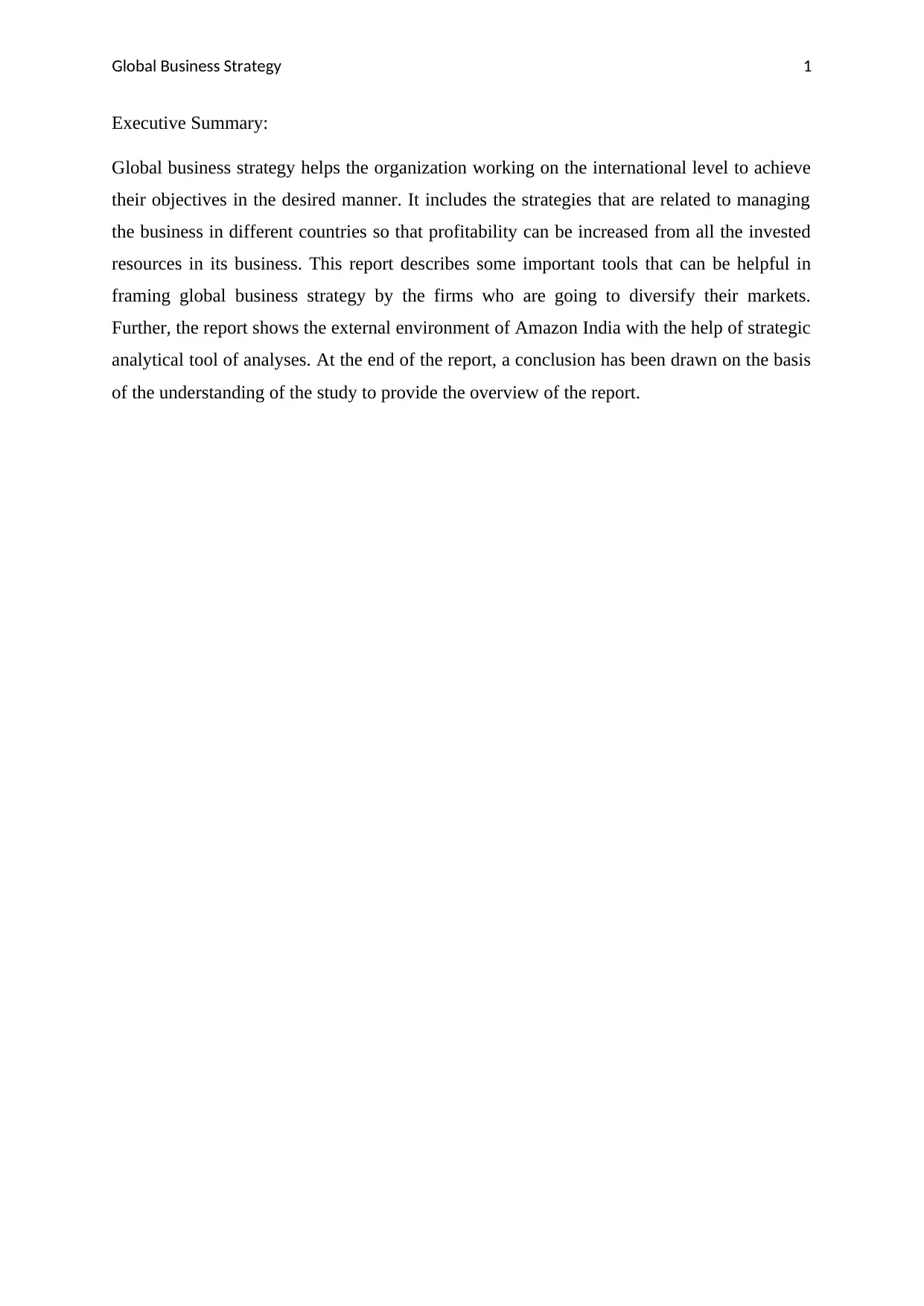
Global Business Strategy 1
Executive Summary:
Global business strategy helps the organization working on the international level to achieve
their objectives in the desired manner. It includes the strategies that are related to managing
the business in different countries so that profitability can be increased from all the invested
resources in its business. This report describes some important tools that can be helpful in
framing global business strategy by the firms who are going to diversify their markets.
Further, the report shows the external environment of Amazon India with the help of strategic
analytical tool of analyses. At the end of the report, a conclusion has been drawn on the basis
of the understanding of the study to provide the overview of the report.
Executive Summary:
Global business strategy helps the organization working on the international level to achieve
their objectives in the desired manner. It includes the strategies that are related to managing
the business in different countries so that profitability can be increased from all the invested
resources in its business. This report describes some important tools that can be helpful in
framing global business strategy by the firms who are going to diversify their markets.
Further, the report shows the external environment of Amazon India with the help of strategic
analytical tool of analyses. At the end of the report, a conclusion has been drawn on the basis
of the understanding of the study to provide the overview of the report.
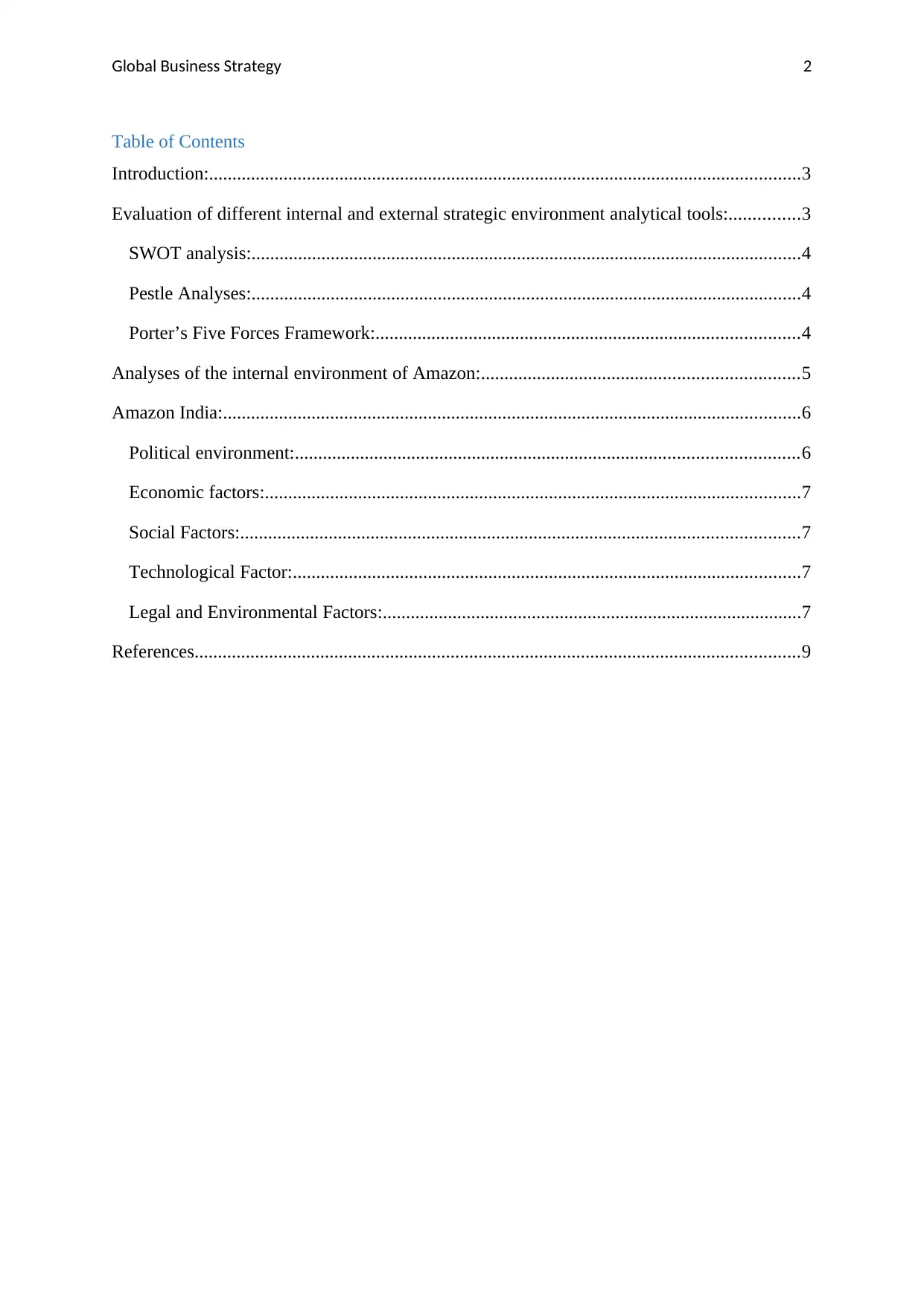
Global Business Strategy 2
Table of Contents
Introduction:...............................................................................................................................3
Evaluation of different internal and external strategic environment analytical tools:...............3
SWOT analysis:......................................................................................................................4
Pestle Analyses:......................................................................................................................4
Porter’s Five Forces Framework:...........................................................................................4
Analyses of the internal environment of Amazon:....................................................................5
Amazon India:............................................................................................................................6
Political environment:............................................................................................................6
Economic factors:...................................................................................................................7
Social Factors:........................................................................................................................7
Technological Factor:.............................................................................................................7
Legal and Environmental Factors:..........................................................................................7
References..................................................................................................................................9
Table of Contents
Introduction:...............................................................................................................................3
Evaluation of different internal and external strategic environment analytical tools:...............3
SWOT analysis:......................................................................................................................4
Pestle Analyses:......................................................................................................................4
Porter’s Five Forces Framework:...........................................................................................4
Analyses of the internal environment of Amazon:....................................................................5
Amazon India:............................................................................................................................6
Political environment:............................................................................................................6
Economic factors:...................................................................................................................7
Social Factors:........................................................................................................................7
Technological Factor:.............................................................................................................7
Legal and Environmental Factors:..........................................................................................7
References..................................................................................................................................9
⊘ This is a preview!⊘
Do you want full access?
Subscribe today to unlock all pages.

Trusted by 1+ million students worldwide
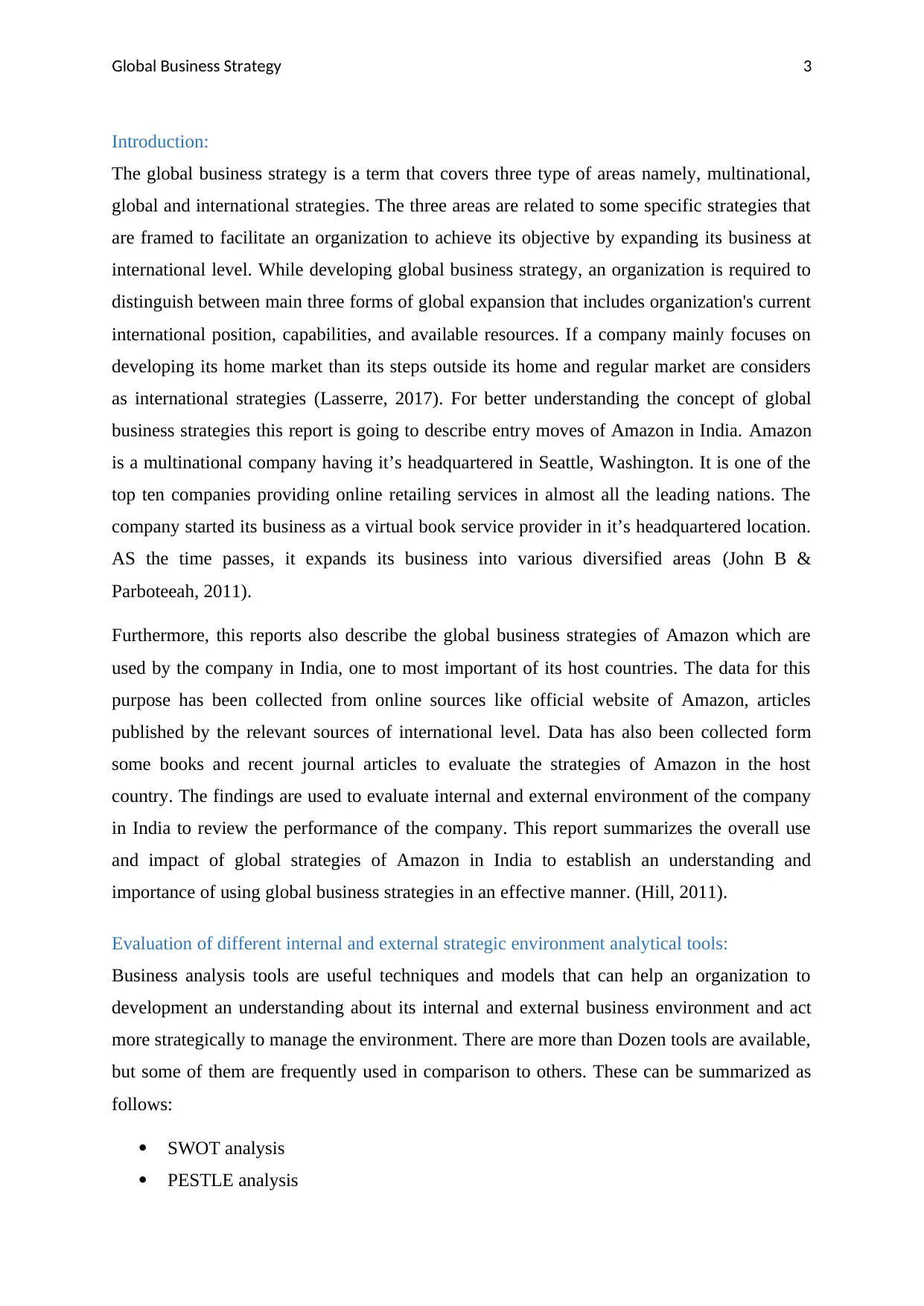
Global Business Strategy 3
Introduction:
The global business strategy is a term that covers three type of areas namely, multinational,
global and international strategies. The three areas are related to some specific strategies that
are framed to facilitate an organization to achieve its objective by expanding its business at
international level. While developing global business strategy, an organization is required to
distinguish between main three forms of global expansion that includes organization's current
international position, capabilities, and available resources. If a company mainly focuses on
developing its home market than its steps outside its home and regular market are considers
as international strategies (Lasserre, 2017). For better understanding the concept of global
business strategies this report is going to describe entry moves of Amazon in India. Amazon
is a multinational company having it’s headquartered in Seattle, Washington. It is one of the
top ten companies providing online retailing services in almost all the leading nations. The
company started its business as a virtual book service provider in it’s headquartered location.
AS the time passes, it expands its business into various diversified areas (John B &
Parboteeah, 2011).
Furthermore, this reports also describe the global business strategies of Amazon which are
used by the company in India, one to most important of its host countries. The data for this
purpose has been collected from online sources like official website of Amazon, articles
published by the relevant sources of international level. Data has also been collected form
some books and recent journal articles to evaluate the strategies of Amazon in the host
country. The findings are used to evaluate internal and external environment of the company
in India to review the performance of the company. This report summarizes the overall use
and impact of global strategies of Amazon in India to establish an understanding and
importance of using global business strategies in an effective manner. (Hill, 2011).
Evaluation of different internal and external strategic environment analytical tools:
Business analysis tools are useful techniques and models that can help an organization to
development an understanding about its internal and external business environment and act
more strategically to manage the environment. There are more than Dozen tools are available,
but some of them are frequently used in comparison to others. These can be summarized as
follows:
SWOT analysis
PESTLE analysis
Introduction:
The global business strategy is a term that covers three type of areas namely, multinational,
global and international strategies. The three areas are related to some specific strategies that
are framed to facilitate an organization to achieve its objective by expanding its business at
international level. While developing global business strategy, an organization is required to
distinguish between main three forms of global expansion that includes organization's current
international position, capabilities, and available resources. If a company mainly focuses on
developing its home market than its steps outside its home and regular market are considers
as international strategies (Lasserre, 2017). For better understanding the concept of global
business strategies this report is going to describe entry moves of Amazon in India. Amazon
is a multinational company having it’s headquartered in Seattle, Washington. It is one of the
top ten companies providing online retailing services in almost all the leading nations. The
company started its business as a virtual book service provider in it’s headquartered location.
AS the time passes, it expands its business into various diversified areas (John B &
Parboteeah, 2011).
Furthermore, this reports also describe the global business strategies of Amazon which are
used by the company in India, one to most important of its host countries. The data for this
purpose has been collected from online sources like official website of Amazon, articles
published by the relevant sources of international level. Data has also been collected form
some books and recent journal articles to evaluate the strategies of Amazon in the host
country. The findings are used to evaluate internal and external environment of the company
in India to review the performance of the company. This report summarizes the overall use
and impact of global strategies of Amazon in India to establish an understanding and
importance of using global business strategies in an effective manner. (Hill, 2011).
Evaluation of different internal and external strategic environment analytical tools:
Business analysis tools are useful techniques and models that can help an organization to
development an understanding about its internal and external business environment and act
more strategically to manage the environment. There are more than Dozen tools are available,
but some of them are frequently used in comparison to others. These can be summarized as
follows:
SWOT analysis
PESTLE analysis
Paraphrase This Document
Need a fresh take? Get an instant paraphrase of this document with our AI Paraphraser
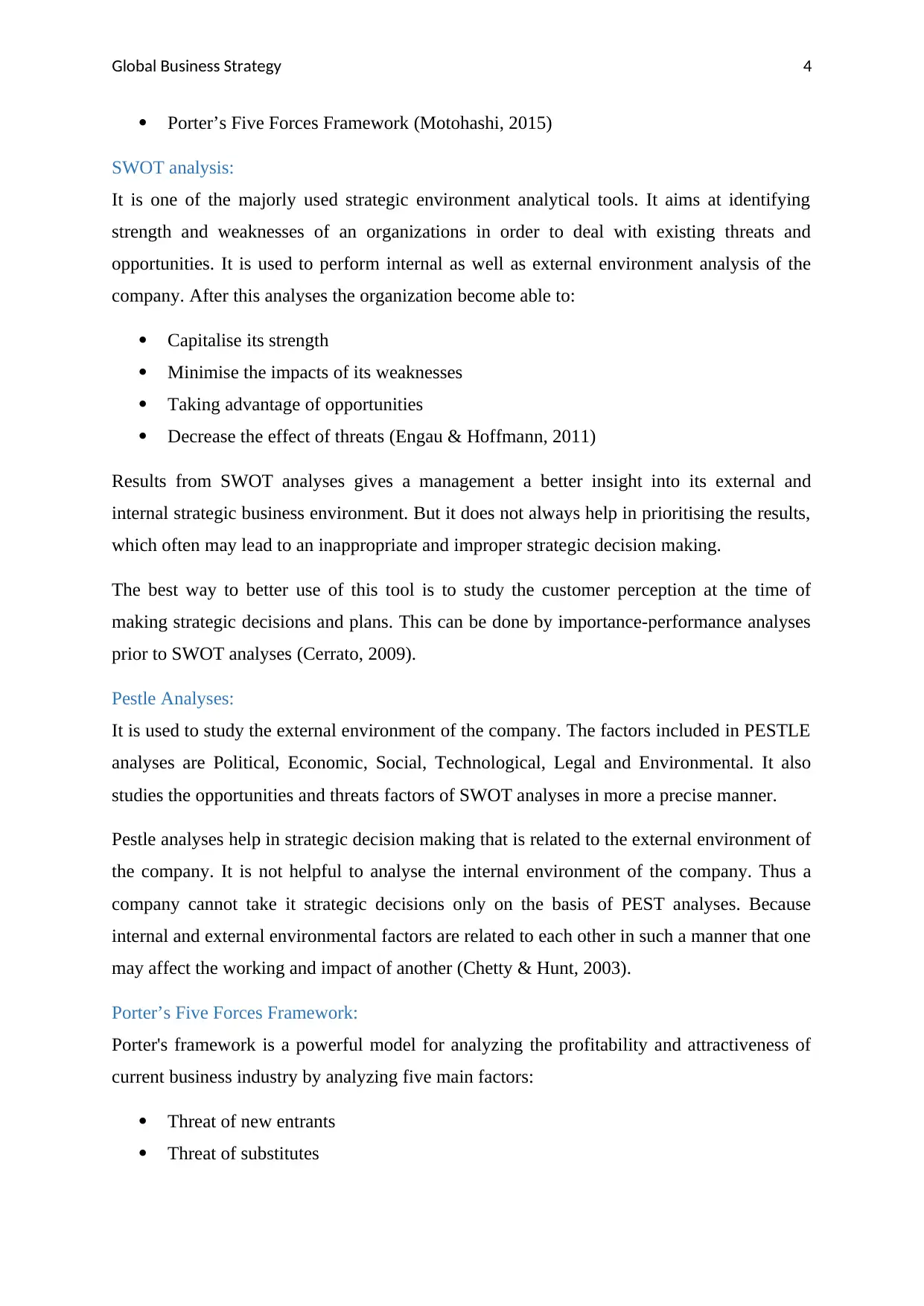
Global Business Strategy 4
Porter’s Five Forces Framework (Motohashi, 2015)
SWOT analysis:
It is one of the majorly used strategic environment analytical tools. It aims at identifying
strength and weaknesses of an organizations in order to deal with existing threats and
opportunities. It is used to perform internal as well as external environment analysis of the
company. After this analyses the organization become able to:
Capitalise its strength
Minimise the impacts of its weaknesses
Taking advantage of opportunities
Decrease the effect of threats (Engau & Hoffmann, 2011)
Results from SWOT analyses gives a management a better insight into its external and
internal strategic business environment. But it does not always help in prioritising the results,
which often may lead to an inappropriate and improper strategic decision making.
The best way to better use of this tool is to study the customer perception at the time of
making strategic decisions and plans. This can be done by importance-performance analyses
prior to SWOT analyses (Cerrato, 2009).
Pestle Analyses:
It is used to study the external environment of the company. The factors included in PESTLE
analyses are Political, Economic, Social, Technological, Legal and Environmental. It also
studies the opportunities and threats factors of SWOT analyses in more a precise manner.
Pestle analyses help in strategic decision making that is related to the external environment of
the company. It is not helpful to analyse the internal environment of the company. Thus a
company cannot take it strategic decisions only on the basis of PEST analyses. Because
internal and external environmental factors are related to each other in such a manner that one
may affect the working and impact of another (Chetty & Hunt, 2003).
Porter’s Five Forces Framework:
Porter's framework is a powerful model for analyzing the profitability and attractiveness of
current business industry by analyzing five main factors:
Threat of new entrants
Threat of substitutes
Porter’s Five Forces Framework (Motohashi, 2015)
SWOT analysis:
It is one of the majorly used strategic environment analytical tools. It aims at identifying
strength and weaknesses of an organizations in order to deal with existing threats and
opportunities. It is used to perform internal as well as external environment analysis of the
company. After this analyses the organization become able to:
Capitalise its strength
Minimise the impacts of its weaknesses
Taking advantage of opportunities
Decrease the effect of threats (Engau & Hoffmann, 2011)
Results from SWOT analyses gives a management a better insight into its external and
internal strategic business environment. But it does not always help in prioritising the results,
which often may lead to an inappropriate and improper strategic decision making.
The best way to better use of this tool is to study the customer perception at the time of
making strategic decisions and plans. This can be done by importance-performance analyses
prior to SWOT analyses (Cerrato, 2009).
Pestle Analyses:
It is used to study the external environment of the company. The factors included in PESTLE
analyses are Political, Economic, Social, Technological, Legal and Environmental. It also
studies the opportunities and threats factors of SWOT analyses in more a precise manner.
Pestle analyses help in strategic decision making that is related to the external environment of
the company. It is not helpful to analyse the internal environment of the company. Thus a
company cannot take it strategic decisions only on the basis of PEST analyses. Because
internal and external environmental factors are related to each other in such a manner that one
may affect the working and impact of another (Chetty & Hunt, 2003).
Porter’s Five Forces Framework:
Porter's framework is a powerful model for analyzing the profitability and attractiveness of
current business industry by analyzing five main factors:
Threat of new entrants
Threat of substitutes
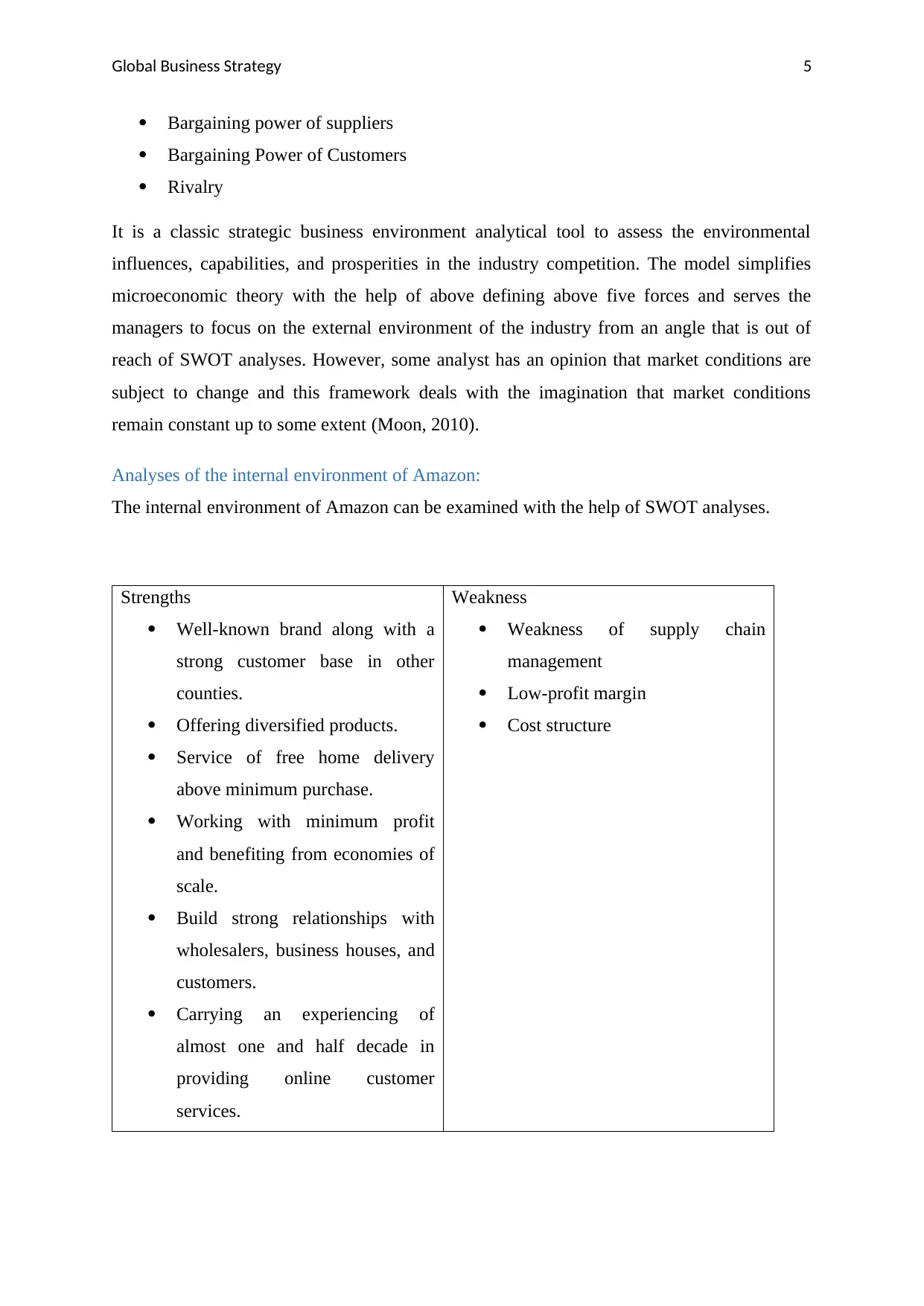
Global Business Strategy 5
Bargaining power of suppliers
Bargaining Power of Customers
Rivalry
It is a classic strategic business environment analytical tool to assess the environmental
influences, capabilities, and prosperities in the industry competition. The model simplifies
microeconomic theory with the help of above defining above five forces and serves the
managers to focus on the external environment of the industry from an angle that is out of
reach of SWOT analyses. However, some analyst has an opinion that market conditions are
subject to change and this framework deals with the imagination that market conditions
remain constant up to some extent (Moon, 2010).
Analyses of the internal environment of Amazon:
The internal environment of Amazon can be examined with the help of SWOT analyses.
Strengths
Well-known brand along with a
strong customer base in other
counties.
Offering diversified products.
Service of free home delivery
above minimum purchase.
Working with minimum profit
and benefiting from economies of
scale.
Build strong relationships with
wholesalers, business houses, and
customers.
Carrying an experiencing of
almost one and half decade in
providing online customer
services.
Weakness
Weakness of supply chain
management
Low-profit margin
Cost structure
Bargaining power of suppliers
Bargaining Power of Customers
Rivalry
It is a classic strategic business environment analytical tool to assess the environmental
influences, capabilities, and prosperities in the industry competition. The model simplifies
microeconomic theory with the help of above defining above five forces and serves the
managers to focus on the external environment of the industry from an angle that is out of
reach of SWOT analyses. However, some analyst has an opinion that market conditions are
subject to change and this framework deals with the imagination that market conditions
remain constant up to some extent (Moon, 2010).
Analyses of the internal environment of Amazon:
The internal environment of Amazon can be examined with the help of SWOT analyses.
Strengths
Well-known brand along with a
strong customer base in other
counties.
Offering diversified products.
Service of free home delivery
above minimum purchase.
Working with minimum profit
and benefiting from economies of
scale.
Build strong relationships with
wholesalers, business houses, and
customers.
Carrying an experiencing of
almost one and half decade in
providing online customer
services.
Weakness
Weakness of supply chain
management
Low-profit margin
Cost structure
⊘ This is a preview!⊘
Do you want full access?
Subscribe today to unlock all pages.

Trusted by 1+ million students worldwide
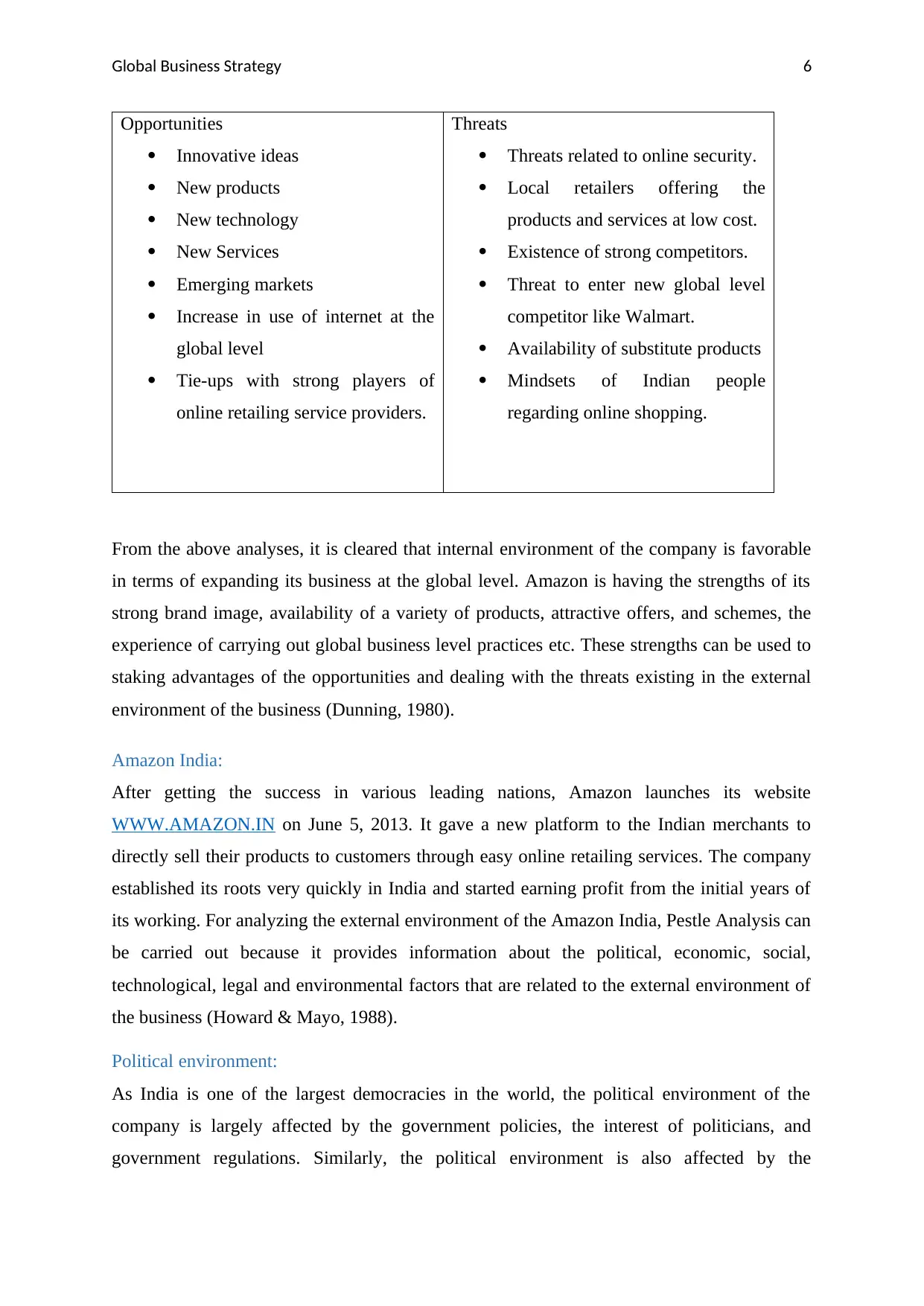
Global Business Strategy 6
Opportunities
Innovative ideas
New products
New technology
New Services
Emerging markets
Increase in use of internet at the
global level
Tie-ups with strong players of
online retailing service providers.
Threats
Threats related to online security.
Local retailers offering the
products and services at low cost.
Existence of strong competitors.
Threat to enter new global level
competitor like Walmart.
Availability of substitute products
Mindsets of Indian people
regarding online shopping.
From the above analyses, it is cleared that internal environment of the company is favorable
in terms of expanding its business at the global level. Amazon is having the strengths of its
strong brand image, availability of a variety of products, attractive offers, and schemes, the
experience of carrying out global business level practices etc. These strengths can be used to
staking advantages of the opportunities and dealing with the threats existing in the external
environment of the business (Dunning, 1980).
Amazon India:
After getting the success in various leading nations, Amazon launches its website
WWW.AMAZON.IN on June 5, 2013. It gave a new platform to the Indian merchants to
directly sell their products to customers through easy online retailing services. The company
established its roots very quickly in India and started earning profit from the initial years of
its working. For analyzing the external environment of the Amazon India, Pestle Analysis can
be carried out because it provides information about the political, economic, social,
technological, legal and environmental factors that are related to the external environment of
the business (Howard & Mayo, 1988).
Political environment:
As India is one of the largest democracies in the world, the political environment of the
company is largely affected by the government policies, the interest of politicians, and
government regulations. Similarly, the political environment is also affected by the
Opportunities
Innovative ideas
New products
New technology
New Services
Emerging markets
Increase in use of internet at the
global level
Tie-ups with strong players of
online retailing service providers.
Threats
Threats related to online security.
Local retailers offering the
products and services at low cost.
Existence of strong competitors.
Threat to enter new global level
competitor like Walmart.
Availability of substitute products
Mindsets of Indian people
regarding online shopping.
From the above analyses, it is cleared that internal environment of the company is favorable
in terms of expanding its business at the global level. Amazon is having the strengths of its
strong brand image, availability of a variety of products, attractive offers, and schemes, the
experience of carrying out global business level practices etc. These strengths can be used to
staking advantages of the opportunities and dealing with the threats existing in the external
environment of the business (Dunning, 1980).
Amazon India:
After getting the success in various leading nations, Amazon launches its website
WWW.AMAZON.IN on June 5, 2013. It gave a new platform to the Indian merchants to
directly sell their products to customers through easy online retailing services. The company
established its roots very quickly in India and started earning profit from the initial years of
its working. For analyzing the external environment of the Amazon India, Pestle Analysis can
be carried out because it provides information about the political, economic, social,
technological, legal and environmental factors that are related to the external environment of
the business (Howard & Mayo, 1988).
Political environment:
As India is one of the largest democracies in the world, the political environment of the
company is largely affected by the government policies, the interest of politicians, and
government regulations. Similarly, the political environment is also affected by the
Paraphrase This Document
Need a fresh take? Get an instant paraphrase of this document with our AI Paraphraser
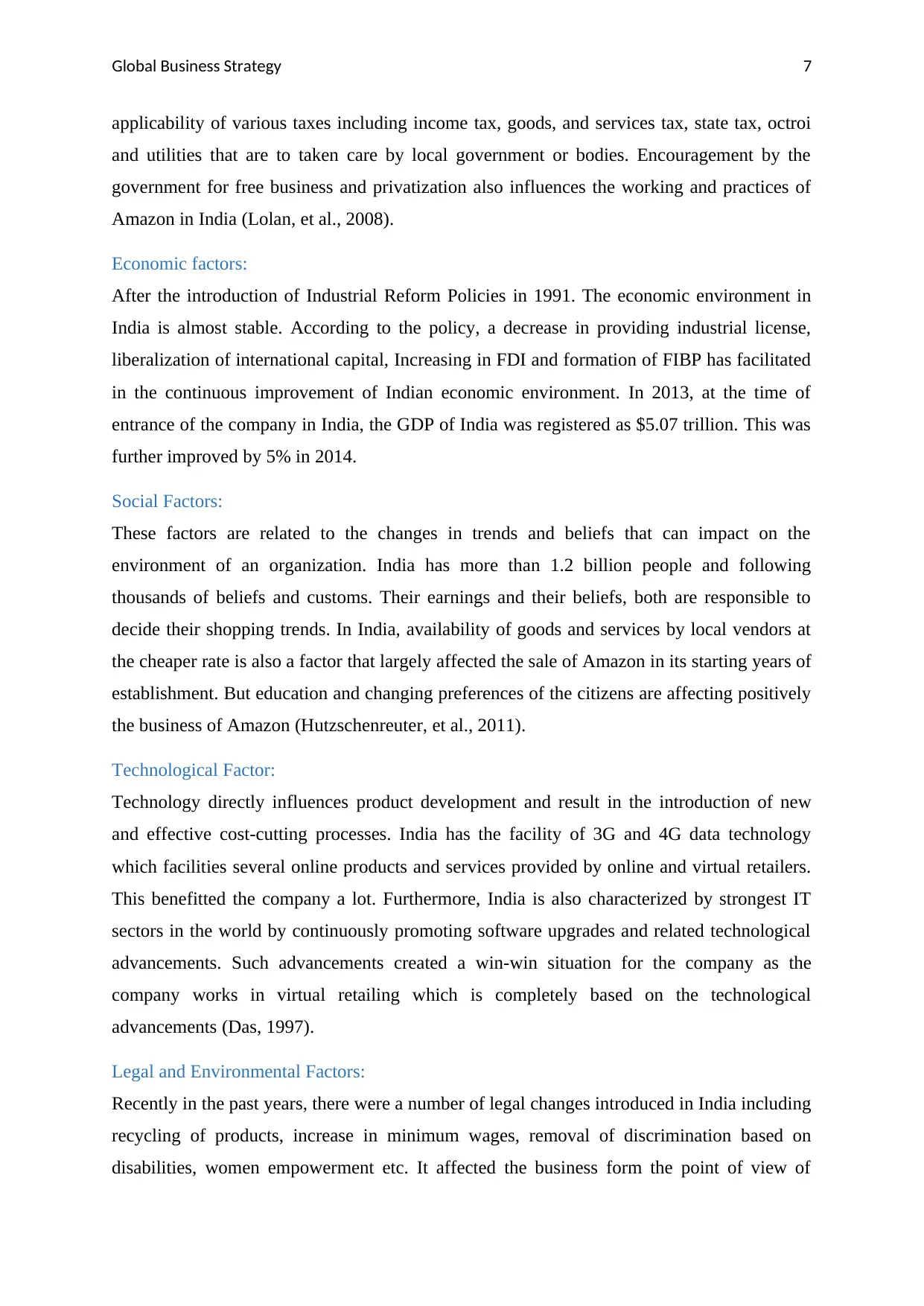
Global Business Strategy 7
applicability of various taxes including income tax, goods, and services tax, state tax, octroi
and utilities that are to taken care by local government or bodies. Encouragement by the
government for free business and privatization also influences the working and practices of
Amazon in India (Lolan, et al., 2008).
Economic factors:
After the introduction of Industrial Reform Policies in 1991. The economic environment in
India is almost stable. According to the policy, a decrease in providing industrial license,
liberalization of international capital, Increasing in FDI and formation of FIBP has facilitated
in the continuous improvement of Indian economic environment. In 2013, at the time of
entrance of the company in India, the GDP of India was registered as $5.07 trillion. This was
further improved by 5% in 2014.
Social Factors:
These factors are related to the changes in trends and beliefs that can impact on the
environment of an organization. India has more than 1.2 billion people and following
thousands of beliefs and customs. Their earnings and their beliefs, both are responsible to
decide their shopping trends. In India, availability of goods and services by local vendors at
the cheaper rate is also a factor that largely affected the sale of Amazon in its starting years of
establishment. But education and changing preferences of the citizens are affecting positively
the business of Amazon (Hutzschenreuter, et al., 2011).
Technological Factor:
Technology directly influences product development and result in the introduction of new
and effective cost-cutting processes. India has the facility of 3G and 4G data technology
which facilities several online products and services provided by online and virtual retailers.
This benefitted the company a lot. Furthermore, India is also characterized by strongest IT
sectors in the world by continuously promoting software upgrades and related technological
advancements. Such advancements created a win-win situation for the company as the
company works in virtual retailing which is completely based on the technological
advancements (Das, 1997).
Legal and Environmental Factors:
Recently in the past years, there were a number of legal changes introduced in India including
recycling of products, increase in minimum wages, removal of discrimination based on
disabilities, women empowerment etc. It affected the business form the point of view of
applicability of various taxes including income tax, goods, and services tax, state tax, octroi
and utilities that are to taken care by local government or bodies. Encouragement by the
government for free business and privatization also influences the working and practices of
Amazon in India (Lolan, et al., 2008).
Economic factors:
After the introduction of Industrial Reform Policies in 1991. The economic environment in
India is almost stable. According to the policy, a decrease in providing industrial license,
liberalization of international capital, Increasing in FDI and formation of FIBP has facilitated
in the continuous improvement of Indian economic environment. In 2013, at the time of
entrance of the company in India, the GDP of India was registered as $5.07 trillion. This was
further improved by 5% in 2014.
Social Factors:
These factors are related to the changes in trends and beliefs that can impact on the
environment of an organization. India has more than 1.2 billion people and following
thousands of beliefs and customs. Their earnings and their beliefs, both are responsible to
decide their shopping trends. In India, availability of goods and services by local vendors at
the cheaper rate is also a factor that largely affected the sale of Amazon in its starting years of
establishment. But education and changing preferences of the citizens are affecting positively
the business of Amazon (Hutzschenreuter, et al., 2011).
Technological Factor:
Technology directly influences product development and result in the introduction of new
and effective cost-cutting processes. India has the facility of 3G and 4G data technology
which facilities several online products and services provided by online and virtual retailers.
This benefitted the company a lot. Furthermore, India is also characterized by strongest IT
sectors in the world by continuously promoting software upgrades and related technological
advancements. Such advancements created a win-win situation for the company as the
company works in virtual retailing which is completely based on the technological
advancements (Das, 1997).
Legal and Environmental Factors:
Recently in the past years, there were a number of legal changes introduced in India including
recycling of products, increase in minimum wages, removal of discrimination based on
disabilities, women empowerment etc. It affected the business form the point of view of
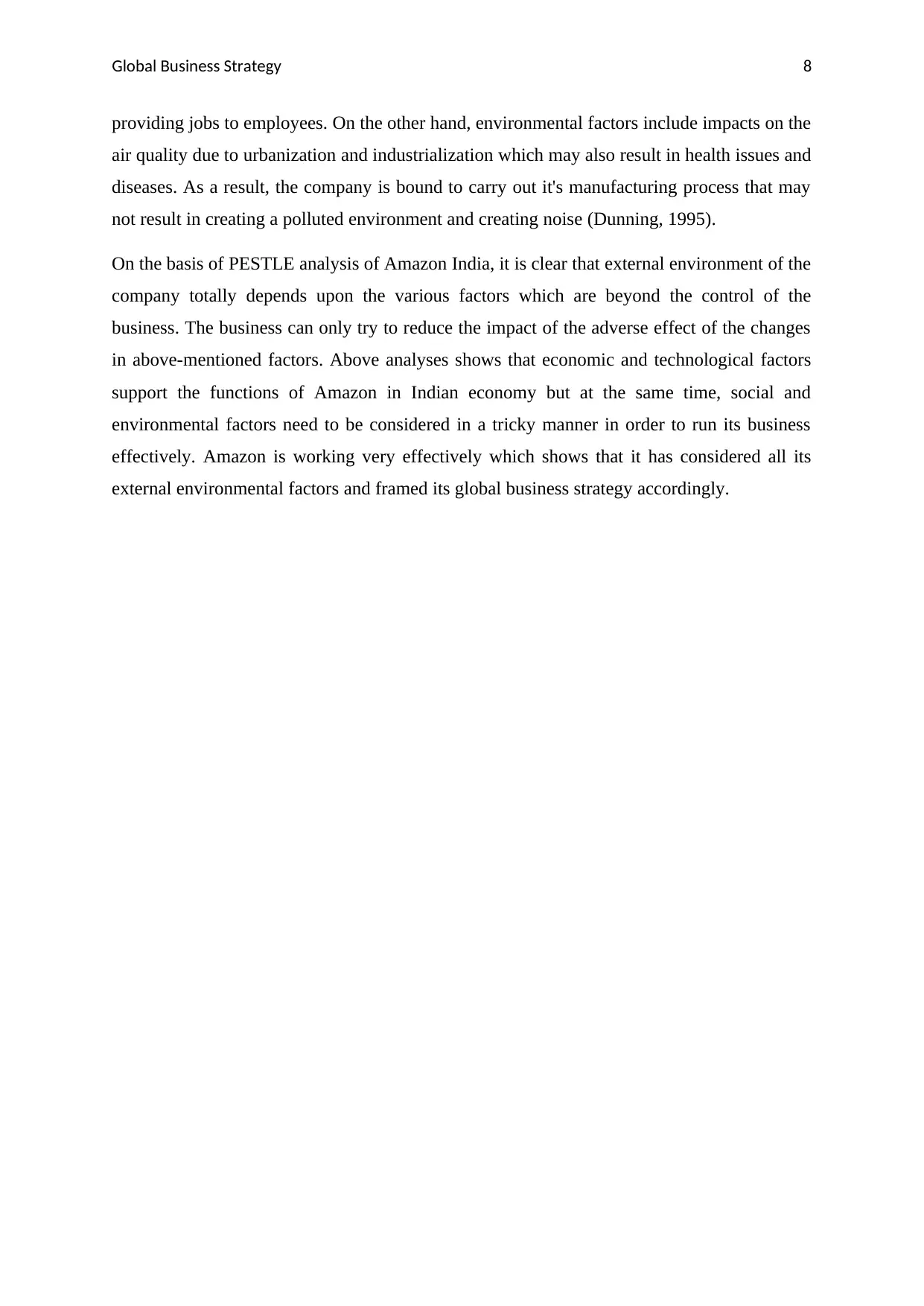
Global Business Strategy 8
providing jobs to employees. On the other hand, environmental factors include impacts on the
air quality due to urbanization and industrialization which may also result in health issues and
diseases. As a result, the company is bound to carry out it's manufacturing process that may
not result in creating a polluted environment and creating noise (Dunning, 1995).
On the basis of PESTLE analysis of Amazon India, it is clear that external environment of the
company totally depends upon the various factors which are beyond the control of the
business. The business can only try to reduce the impact of the adverse effect of the changes
in above-mentioned factors. Above analyses shows that economic and technological factors
support the functions of Amazon in Indian economy but at the same time, social and
environmental factors need to be considered in a tricky manner in order to run its business
effectively. Amazon is working very effectively which shows that it has considered all its
external environmental factors and framed its global business strategy accordingly.
providing jobs to employees. On the other hand, environmental factors include impacts on the
air quality due to urbanization and industrialization which may also result in health issues and
diseases. As a result, the company is bound to carry out it's manufacturing process that may
not result in creating a polluted environment and creating noise (Dunning, 1995).
On the basis of PESTLE analysis of Amazon India, it is clear that external environment of the
company totally depends upon the various factors which are beyond the control of the
business. The business can only try to reduce the impact of the adverse effect of the changes
in above-mentioned factors. Above analyses shows that economic and technological factors
support the functions of Amazon in Indian economy but at the same time, social and
environmental factors need to be considered in a tricky manner in order to run its business
effectively. Amazon is working very effectively which shows that it has considered all its
external environmental factors and framed its global business strategy accordingly.
⊘ This is a preview!⊘
Do you want full access?
Subscribe today to unlock all pages.

Trusted by 1+ million students worldwide
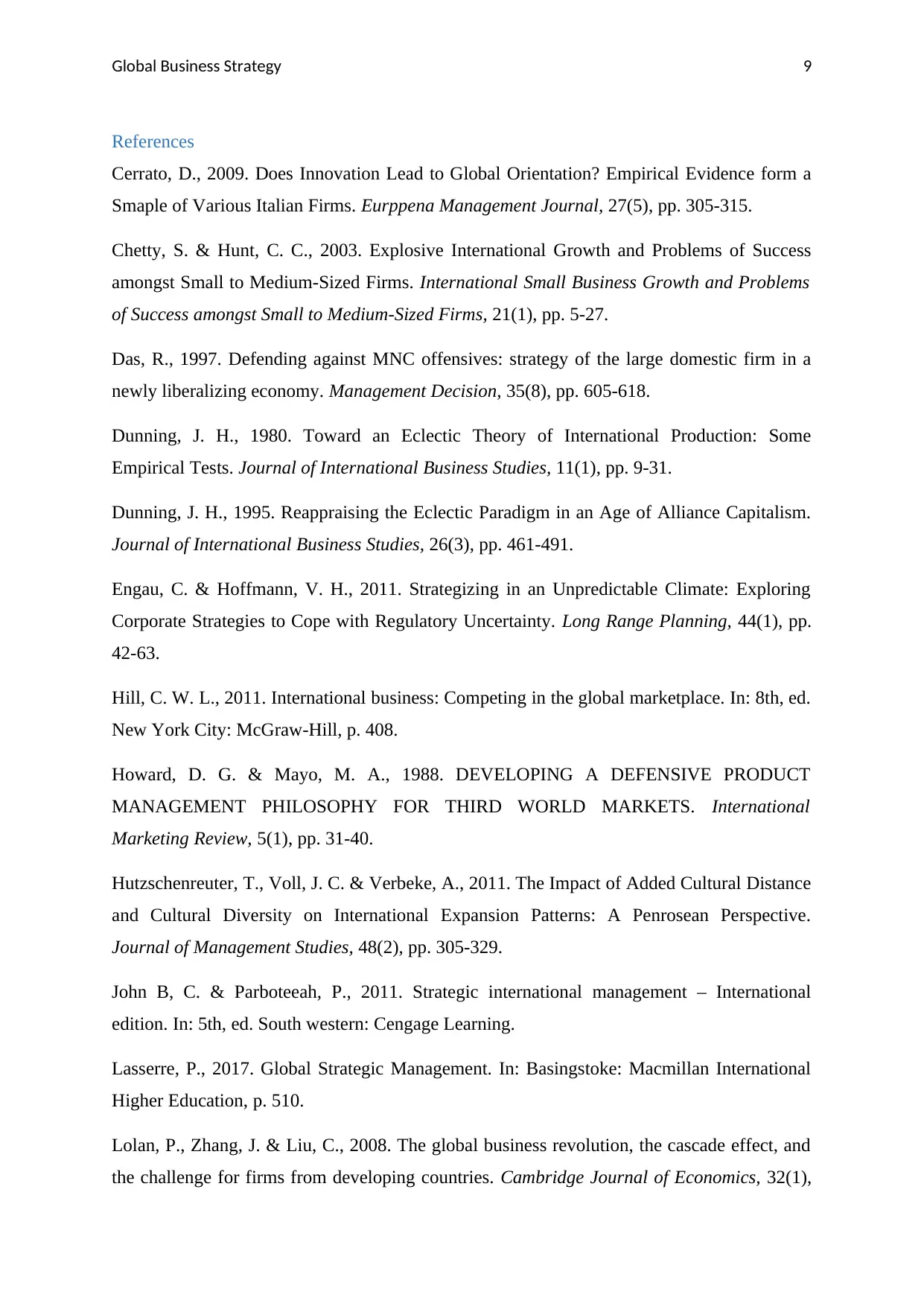
Global Business Strategy 9
References
Cerrato, D., 2009. Does Innovation Lead to Global Orientation? Empirical Evidence form a
Smaple of Various Italian Firms. Eurppena Management Journal, 27(5), pp. 305-315.
Chetty, S. & Hunt, C. C., 2003. Explosive International Growth and Problems of Success
amongst Small to Medium-Sized Firms. International Small Business Growth and Problems
of Success amongst Small to Medium-Sized Firms, 21(1), pp. 5-27.
Das, R., 1997. Defending against MNC offensives: strategy of the large domestic firm in a
newly liberalizing economy. Management Decision, 35(8), pp. 605-618.
Dunning, J. H., 1980. Toward an Eclectic Theory of International Production: Some
Empirical Tests. Journal of International Business Studies, 11(1), pp. 9-31.
Dunning, J. H., 1995. Reappraising the Eclectic Paradigm in an Age of Alliance Capitalism.
Journal of International Business Studies, 26(3), pp. 461-491.
Engau, C. & Hoffmann, V. H., 2011. Strategizing in an Unpredictable Climate: Exploring
Corporate Strategies to Cope with Regulatory Uncertainty. Long Range Planning, 44(1), pp.
42-63.
Hill, C. W. L., 2011. International business: Competing in the global marketplace. In: 8th, ed.
New York City: McGraw-Hill, p. 408.
Howard, D. G. & Mayo, M. A., 1988. DEVELOPING A DEFENSIVE PRODUCT
MANAGEMENT PHILOSOPHY FOR THIRD WORLD MARKETS. International
Marketing Review, 5(1), pp. 31-40.
Hutzschenreuter, T., Voll, J. C. & Verbeke, A., 2011. The Impact of Added Cultural Distance
and Cultural Diversity on International Expansion Patterns: A Penrosean Perspective.
Journal of Management Studies, 48(2), pp. 305-329.
John B, C. & Parboteeah, P., 2011. Strategic international management – International
edition. In: 5th, ed. South western: Cengage Learning.
Lasserre, P., 2017. Global Strategic Management. In: Basingstoke: Macmillan International
Higher Education, p. 510.
Lolan, P., Zhang, J. & Liu, C., 2008. The global business revolution, the cascade effect, and
the challenge for firms from developing countries. Cambridge Journal of Economics, 32(1),
References
Cerrato, D., 2009. Does Innovation Lead to Global Orientation? Empirical Evidence form a
Smaple of Various Italian Firms. Eurppena Management Journal, 27(5), pp. 305-315.
Chetty, S. & Hunt, C. C., 2003. Explosive International Growth and Problems of Success
amongst Small to Medium-Sized Firms. International Small Business Growth and Problems
of Success amongst Small to Medium-Sized Firms, 21(1), pp. 5-27.
Das, R., 1997. Defending against MNC offensives: strategy of the large domestic firm in a
newly liberalizing economy. Management Decision, 35(8), pp. 605-618.
Dunning, J. H., 1980. Toward an Eclectic Theory of International Production: Some
Empirical Tests. Journal of International Business Studies, 11(1), pp. 9-31.
Dunning, J. H., 1995. Reappraising the Eclectic Paradigm in an Age of Alliance Capitalism.
Journal of International Business Studies, 26(3), pp. 461-491.
Engau, C. & Hoffmann, V. H., 2011. Strategizing in an Unpredictable Climate: Exploring
Corporate Strategies to Cope with Regulatory Uncertainty. Long Range Planning, 44(1), pp.
42-63.
Hill, C. W. L., 2011. International business: Competing in the global marketplace. In: 8th, ed.
New York City: McGraw-Hill, p. 408.
Howard, D. G. & Mayo, M. A., 1988. DEVELOPING A DEFENSIVE PRODUCT
MANAGEMENT PHILOSOPHY FOR THIRD WORLD MARKETS. International
Marketing Review, 5(1), pp. 31-40.
Hutzschenreuter, T., Voll, J. C. & Verbeke, A., 2011. The Impact of Added Cultural Distance
and Cultural Diversity on International Expansion Patterns: A Penrosean Perspective.
Journal of Management Studies, 48(2), pp. 305-329.
John B, C. & Parboteeah, P., 2011. Strategic international management – International
edition. In: 5th, ed. South western: Cengage Learning.
Lasserre, P., 2017. Global Strategic Management. In: Basingstoke: Macmillan International
Higher Education, p. 510.
Lolan, P., Zhang, J. & Liu, C., 2008. The global business revolution, the cascade effect, and
the challenge for firms from developing countries. Cambridge Journal of Economics, 32(1),
Paraphrase This Document
Need a fresh take? Get an instant paraphrase of this document with our AI Paraphraser
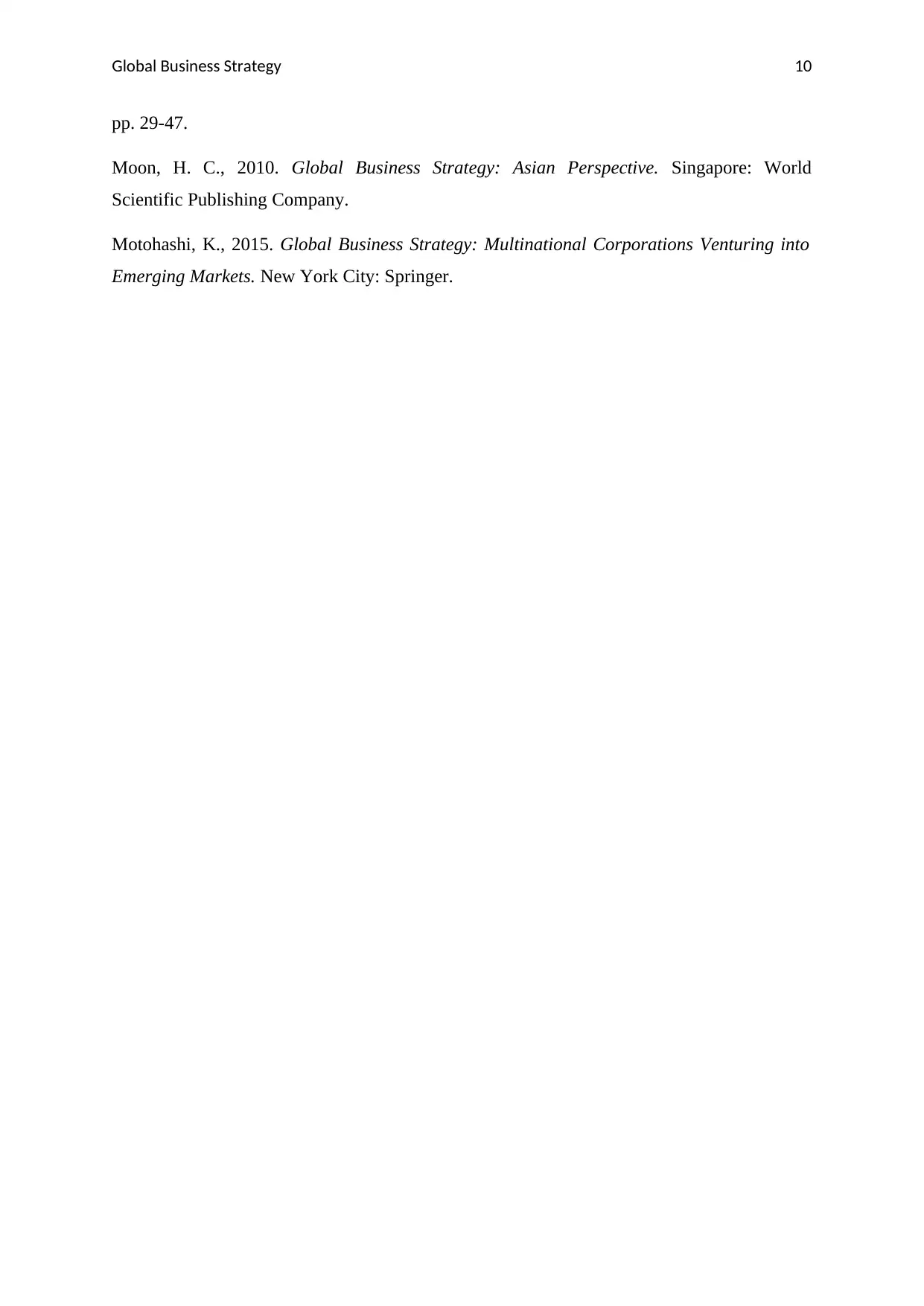
Global Business Strategy 10
pp. 29-47.
Moon, H. C., 2010. Global Business Strategy: Asian Perspective. Singapore: World
Scientific Publishing Company.
Motohashi, K., 2015. Global Business Strategy: Multinational Corporations Venturing into
Emerging Markets. New York City: Springer.
pp. 29-47.
Moon, H. C., 2010. Global Business Strategy: Asian Perspective. Singapore: World
Scientific Publishing Company.
Motohashi, K., 2015. Global Business Strategy: Multinational Corporations Venturing into
Emerging Markets. New York City: Springer.
1 out of 11
Related Documents
Your All-in-One AI-Powered Toolkit for Academic Success.
+13062052269
info@desklib.com
Available 24*7 on WhatsApp / Email
![[object Object]](/_next/static/media/star-bottom.7253800d.svg)
Unlock your academic potential
Copyright © 2020–2025 A2Z Services. All Rights Reserved. Developed and managed by ZUCOL.




